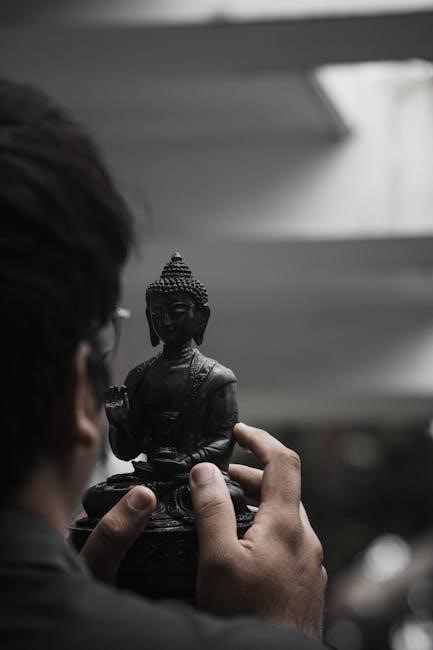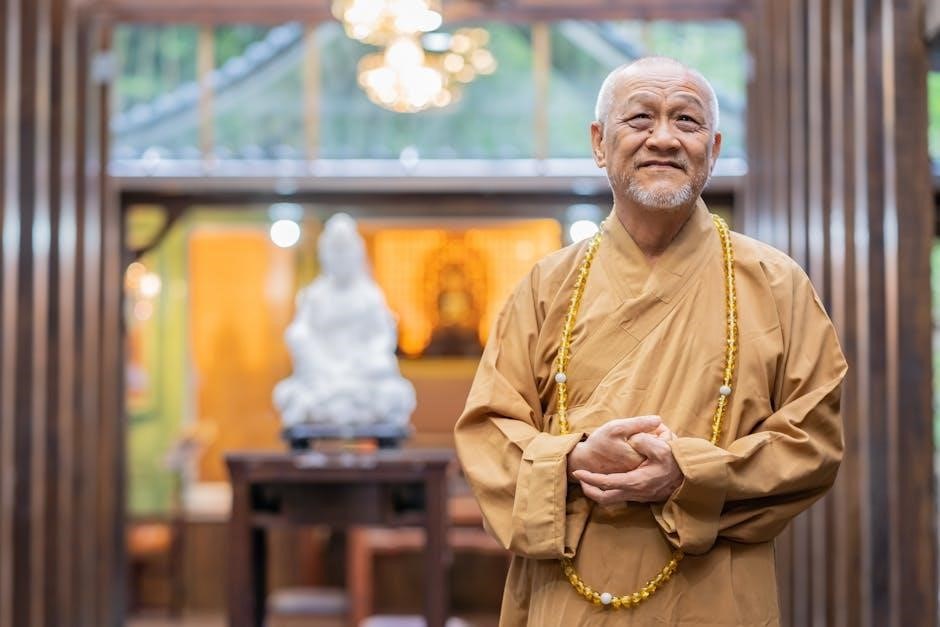Daily Buddhist practice is a spiritual journey fostering mindfulness and meditation. It involves morning and evening rituals, such as gratitude reflection and sutra recitation, promoting mental clarity and compassion. Consistency is key, making it accessible for all seekers of peace and enlightenment.
1.1. Importance of Consistency in Buddhist Practice
Consistency in Buddhist practice strengthens mindfulness and creates a stable foundation for spiritual growth. Regular rituals, such as morning and evening meditations, foster mental clarity and emotional balance. Even brief daily sessions can lead to profound transformation over time. By committing to a steady routine, practitioners cultivate resilience, enabling them to navigate life’s challenges with equanimity and compassion. This steady effort is key to unlocking the full benefits of Buddhist teachings and achieving lasting peace and wisdom.
1.2. Benefits of a Daily Buddhist Practice
A daily Buddhist practice offers numerous benefits, including mental clarity, stress reduction, and emotional balance. Regular meditation fosters resilience, while gratitude and compassion cultivate a positive mindset. These practices enhance self-awareness, helping practitioners navigate life’s challenges with equanimity. By integrating mindfulness and ethical living, individuals can achieve lasting peace and wisdom, leading to a more fulfilling and purpose-driven life. Consistent practice strengthens spiritual growth, making it a powerful tool for personal transformation and harmony in daily life.
Morning Buddhist Practices
Morning Buddhist practices begin with gratitude and mindfulness, setting a positive tone for the day. Meditation, sutra recitation, and reflection cultivate mental clarity and inner peace, fostering spiritual growth and balance in daily life.
2.1. Starting the Day with Gratitude
Beginning the day with gratitude is a cornerstone of Buddhist practice, fostering a positive mindset. Reflect on blessings, no matter how small, and acknowledge life’s goodness. This practice cultivates compassion and mindfulness, setting a harmonious tone for the day. Many traditions include reciting sutras or mantras of gratitude, while others simply take a moment of silence to appreciate life’ssimple joys. Gratitude practice strengthens mental clarity and aligns one with Buddhist values of appreciation and interconnectedness.
2.2. Morning Meditation and Mindfulness
Morning meditation is a foundational practice in Buddhism, fostering mindfulness and mental clarity. Begin by sitting comfortably, focusing on breath or a mantra to cultivate calm. Mindfulness practices, such as body scans or mindful breathing, help anchor the mind in the present. Regular morning meditation sets a positive tone for the day, reducing stress and enhancing focus. Many guides recommend starting with short sessions, gradually increasing duration as the practice deepens, promoting inner peace and alignment with Buddhist teachings.
2.3; Reciting Sutras and Mantras
Reciting sutras and mantras is a core Buddhist practice, purifying the mind and cultivating devotion. Morning and evening recitations, such as the Bodhisattva Vow or Avalokiteshvara mantra, connect practitioners to sacred teachings. This practice strengthens mindfulness, fosters compassion, and brings a sense of harmony. Many guides recommend reciting with focus and sincerity, allowing the words to resonate deeply. Regular recitation supports spiritual growth and aligns one with the Buddha’s wisdom, enhancing daily life with meaning and clarity.

Evening Buddhist Practices
Evening Buddhist practices involve reflecting on actions, reciting sutras, and meditating. These rituals promote mindfulness, gratitude, and inner peace, fostering a balanced and harmonious life.
3.1. Reflecting on the Day’s Actions
Reflecting on the day’s actions is a core evening practice, fostering mindfulness and ethical awareness. It involves reviewing deeds, identifying positive actions, and acknowledging mistakes. This reflection cultivates gratitude, humility, and a commitment to improvement, aligning with Buddhist principles of moral conduct and self-awareness. By examining one’s behavior, practitioners can refine their intentions and align their actions with the Eightfold Path, promoting personal growth and harmony in daily life.
3.2. Evening Meditation for Relaxation
Evening meditation for relaxation is a calming practice that helps unwind the mind and body after a busy day. It involves techniques like deep breathing, body scans, or loving-kindness meditation to release tension and cultivate peace. This practice promotes better sleep, reduces stress, and fosters a sense of inner calm. By incorporating evening meditation, practitioners can reflect on their actions, let go of negativity, and prepare for a restful night, aligning with Buddhist principles of mindfulness and self-care.
3.3. Paying Homage to the Buddha
Paying homage to the Buddha is a respectful practice that cultivates gratitude and mindfulness. It involves bowing, reciting sutras, or chanting mantras to honor the Buddha’s teachings. This practice, often done in the morning or evening, helps practitioners connect with the Buddhist legacy and foster a sense of humility. By paying homage, one acknowledges the Buddha as a guide on the path to enlightenment, reinforcing commitment to the Dharma and nurturing a meaningful spiritual routine.
Key Principles of Buddhist Practice
Daily Buddhist practice is rooted in foundational teachings such as the Eightfold Path, compassion, and mindfulness. These principles guide followers in cultivating inner peace and wisdom.
4.1. The Eightfold Path in Daily Life
The Eightfold Path, a core Buddhist teaching, offers practical guidance for ethical living. It comprises right view, right intention, right speech, right action, right livelihood, right effort, right mindfulness, and right concentration. These principles help cultivate wisdom, ethical behavior, and mental clarity. Integrating them into daily life promotes harmony, reduces suffering, and fosters spiritual growth. By aligning actions and thoughts with these teachings, practitioners embody compassion and mindfulness in all aspects of their lives, creating a balanced and purposeful existence.
4.2. Cultivating Compassion and Loving-Kindness
Cultivating compassion and loving-kindness is central to Buddhist practice. It involves nurturing empathy and goodwill toward oneself and others. Through metta (loving-kindness) meditation, practitioners visualize and radiate kindness to all beings. This practice fosters emotional balance, reduces attachment, and strengthens interconnectedness. Daily acts of compassion, such as helping others or offering kind words, reinforce these values. By integrating loving-kindness into daily life, one cultivates a heart of warmth and understanding, aligning with the Buddha’s teachings on universal love and peace.
4.3. Understanding Impermanence
Understanding impermanence (anitya) is a cornerstone of Buddhist practice. It teaches that all phenomena, including thoughts, emotions, and physical forms, are transient and constantly changing. Practicing mindfulness of impermanence helps cultivate detachment and acceptance. Observing nature, such as the life cycle of a leaf, can deepen this insight. Recognizing impermanence in daily life fosters gratitude, reduces clinging, and brings clarity to the present moment. Embracing this truth liberates the mind from suffering and attachment, aligning one with the natural flow of existence.

Meditation Practices
Meditation is central to Buddhist practice, offering techniques like mindfulness, body scans, and loving-kindness to cultivate mental clarity, reduce stress, and enhance inner focus.
5.1. Mindfulness Meditation for Beginners
Mindfulness meditation is a foundational practice for beginners, fostering present-moment awareness. Start with short sessions, focusing on breath or body sensations. Be gentle with yourself, allowing thoughts to pass without attachment. Regular practice enhances clarity and reduces stress. Use guided resources or apps to ease into the routine. Consistency is key, even if just a few minutes daily. This simple yet profound technique cultivates inner peace and sets the stage for deeper meditation.
5;2. Body Scan Meditation
Body scan meditation involves lying down or sitting comfortably, focusing on sensations in each body part. Start from the toes, moving upward to the head, noting areas of tension or relaxation. This practice enhances physical awareness and releases stress. Regular body scans cultivate mindfulness and compassion toward oneself. For beginners, guided sessions can help maintain focus. Over time, this meditation fosters a deeper connection to the body and promotes overall well-being, aligning with Buddhist principles of self-awareness and healing.
5.3. Loving-Kindness (Metta) Meditation
Loving-kindness meditation focuses on cultivating compassion and goodwill toward oneself and others. Begin by directing kind phrases, such as “May I be happy,” toward yourself, then extend them to friends, neutral individuals, and even those you find challenging. Regular practice fosters emotional harmony and interconnectedness, aligning with Buddhist teachings of universal love and understanding. This meditation is a powerful tool for nurturing a heart of compassion in daily life.

Integrating Buddhist Teachings into Daily Life
Integrating Buddhist teachings involves applying mindfulness, compassion, and ethics in daily activities. Practice mindfulness while working, eating, or commuting, and cultivate loving-kindness in interactions, fostering inner peace and harmony.
6.1. Practicing Mindfulness in Daily Activities
Practicing mindfulness in daily activities involves being fully present in each moment. Pay attention to sights, sounds, and sensations while eating, working, or commuting. Focus on the task at hand without judgment. This practice cultivates clarity, gratitude, and a deeper connection to life. By integrating mindfulness into routine activities, one can transform ordinary tasks into opportunities for spiritual growth and harmony. Regular mindfulness practice fosters a sense of calm and awareness, enriching every aspect of daily life.
6.2. Applying Buddhist Ethics at Work and Home
Applying Buddhist ethics in daily life involves living with honesty, compassion, and fairness. At work, this means treating colleagues with respect and avoiding harm. At home, it fosters a nurturing environment through kindness and understanding. Buddhist ethics, rooted in the Eightfold Path, guide decisions to promote harmony and integrity. By integrating these principles, one cultivates a moral foundation that aligns with spiritual growth and contributes to a peaceful society. Consistent practice of these values transforms both personal and professional relationships.
6.3. Using Buddhist Philosophy for Stress Reduction
Buddhist philosophy offers powerful tools for stress reduction by teaching mindfulness, acceptance, and non-attachment. Practices like meditation and reflection help cultivate a calm mind, enabling individuals to view challenges without emotional reactivity. Understanding impermanence encourages letting go of attachment to outcomes, while compassion and loving-kindness foster inner peace. By embracing these principles, one can transform stress into opportunities for growth, aligning with the teachings of the Dalai Lama and other Buddhist masters who emphasize the importance of mental clarity and resilience in daily life.

Role of Community in Buddhist Practice
Community plays a vital role in Buddhist practice, offering support, guidance, and collective growth. Joining a Sangha or group fosters shared learning and motivation, enriching spiritual journeys.
7.1. Joining a Buddhist Sangha
Joining a Buddhist Sangha provides a supportive community for spiritual growth. It offers collective learning, shared meditation, and rituals, fostering connection and understanding. Participating in group practices, such as reciting sutras and engaging in discussions, strengthens commitment. The Sangha also provides access to resources like PDF guides and teachings from experienced practitioners. By being part of a community, individuals can deepen their practice, find motivation, and integrate Buddhist principles into daily life with guidance and encouragement from fellow practitioners and teachers.
7.2. Participating in Group Meditation Sessions
Group meditation sessions create a collective energy, enhancing focus and mindfulness. They offer a structured environment for practitioners to deepen their practice, fostering a sense of unity and shared intention. Many guides, such as the Daily Buddhist Practice Guide PDF, emphasize the importance of group practice for cultivating compassion and wisdom. Participating in these sessions provides opportunities to learn from others, stay motivated, and integrate meditation into daily life effectively.
7.3. Learning from Buddhist Teachers
Learning from Buddhist teachers provides invaluable guidance for deepening practice. They offer wisdom, clarify doubts, and share practical methods for integrating teachings into daily life. Many resources, such as the Daily Buddhist Practice Guide PDF, highlight the importance of seeking guidance from experienced masters. Teachers help practitioners navigate challenges, cultivate mindfulness, and apply Buddhist principles effectively, ensuring a meaningful and transformative spiritual journey. Their insights empower individuals to embrace compassion, wisdom, and peace in everyday life.
Resources for Daily Buddhist Practice
Utilize eBooks, sutras, and guided meditation apps for structured practice. Downloadable PDF guides offer practical tips, while Buddhist texts like the Tipitaka provide foundational teachings for daily integration.
8.1. Recommended Buddhist Texts and Sutras
Essential Buddhist texts like the Tipitaka and the Heart Sutra offer foundational teachings for daily practice. These scriptures provide guidance on mindfulness, compassion, and the path to enlightenment. Sutras such as the Prajnaparamita and Dhammapada are revered for their wisdom. Modern guides, including PDF eBooks, simplify these teachings, making them accessible for integrating Buddhist philosophy into everyday life. These resources are invaluable for both beginners and advanced practitioners seeking spiritual growth and clarity.
8.2. Best Apps for Buddhist Meditation
Popular apps like Insight Timer and Headspace offer guided Buddhist meditations, timers, and tracking features. These tools support mindfulness, loving-kindness, and body scan practices. Many apps provide access to teachings from experienced Buddhist teachers, helping users deepen their meditation practice. They often include customizable sessions, progress tracking, and community support, making them ideal for maintaining consistency in daily Buddhist meditation. Both free and premium versions are available, catering to various practice levels and preferences.
8.3. Downloadable PDF Guides for Daily Practice
Downloadable PDF guides provide structured routines for daily Buddhist practice, offering step-by-step instructions for meditation, sutra recitation, and mindfulness exercises. Many guides, such as the Daily Buddhist Practice Guide, include reflections on impermanence and compassion. They often feature customizable schedules and teachings from esteemed Buddhist masters. These resources are ideal for both beginners and experienced practitioners, ensuring a consistent and meaningful practice. They can be easily accessed online and saved for daily reference.
Motivation and Commitment
Maintaining a daily Buddhist practice requires commitment and dedication. Celebrate small milestones, set realistic goals, and reflect on progress to stay motivated and inspired consistently.
9.1. Overcoming Challenges in Daily Practice
Challenges in daily Buddhist practice, such as lack of time or motivation, can be overcome by setting realistic goals and celebrating small progress. Seek guidance from teachers or community members, and use resources like PDF guides for structured routines. Reflecting on the benefits of practice, such as mental clarity and compassion, helps maintain dedication. Embrace impermanence and remind yourself that consistent effort leads to spiritual growth and inner peace.
9.2. Setting Realistic Goals for Spiritual Growth
Setting realistic goals for spiritual growth involves creating a structured yet flexible daily practice. Start with manageable routines, such as short meditation sessions or reflection on Buddhist teachings. Utilize resources like PDF guides to help define achievable objectives. Regularly assess progress and adjust goals as needed. Consistency is more important than perfection. By aligning goals with principles like the Eightfold Path and the Five Precepts, you foster a balanced and meaningful spiritual journey, ensuring steady growth and deeper understanding of Buddhist philosophy.
9.3. Celebrating Progress in Buddhist Practice
Celebrating progress in Buddhist practice is essential for maintaining motivation and joy on the spiritual path. Acknowledge even small achievements, like consistent meditation or applying teachings in daily life. Reflect on how your practice has positively impacted your mindset and actions. Express gratitude for the opportunities to grow and learn. Use mindfulness to appreciate each step forward, fostering a sense of accomplishment and encouraging continued dedication to your daily Buddhist practice.
Daily Buddhist practice offers a profound path to mindfulness, compassion, and inner peace. By integrating its teachings, one cultivates mental clarity and fosters a harmonious life.
10.1. Summarizing the Key Points of Daily Buddhist Practice
Daily Buddhist practice fosters mindfulness, compassion, and inner peace through consistent rituals like morning gratitude and evening reflection. Meditation, sutra recitation, and ethical living are core elements. Integrating teachings into daily life, such as applying Buddhist ethics and using philosophy for stress reduction, enhances well-being. Community support through sanghas and group meditations strengthens practice. Utilizing resources like PDF guides and recommended texts aids in maintaining a structured routine. Commitment to these practices cultivates mental clarity and a harmonious journey toward enlightenment and peace.
10.2. Encouragement for Continuous Practice
Embrace daily Buddhist practice with patience and persistence, celebrating small victories along the way. Each moment of mindfulness, meditation, and compassion brings you closer to inner peace and clarity; Remember, the journey is lifelong, and every effort, no matter how small, contributes to spiritual growth and well-being.
Find inspiration in the teachings, your community, and the resources available, such as PDF guides and recommended texts. Stay committed, and let the transformative power of Buddhist practice guide you toward a harmonious and enlightened life.
10.3. Final Thoughts on the Journey of Buddhist Practice
The journey of Buddhist practice is a lifelong path of self-discovery and transformation. By integrating mindfulness, compassion, and wisdom into daily life, one cultivates inner peace and harmony. Embrace the teachings with an open heart, and remember that every step, no matter how small, contributes to spiritual growth. The supportive community, guiding resources, and timeless wisdom of Buddhism will accompany you, inspiring continuous practice and fostering a deeper connection to the present moment and the world around you.
